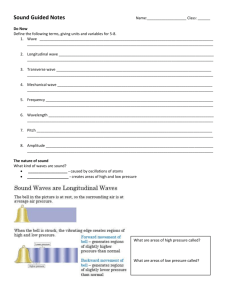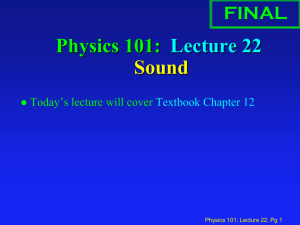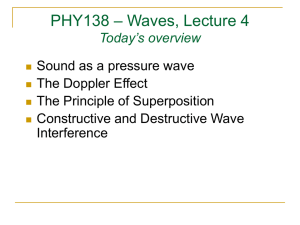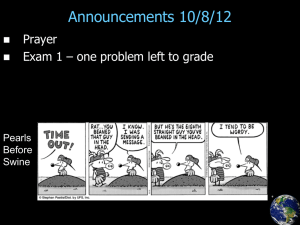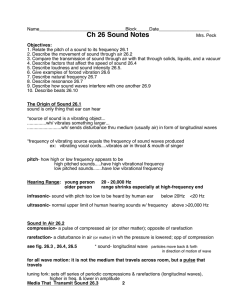1000
advertisement
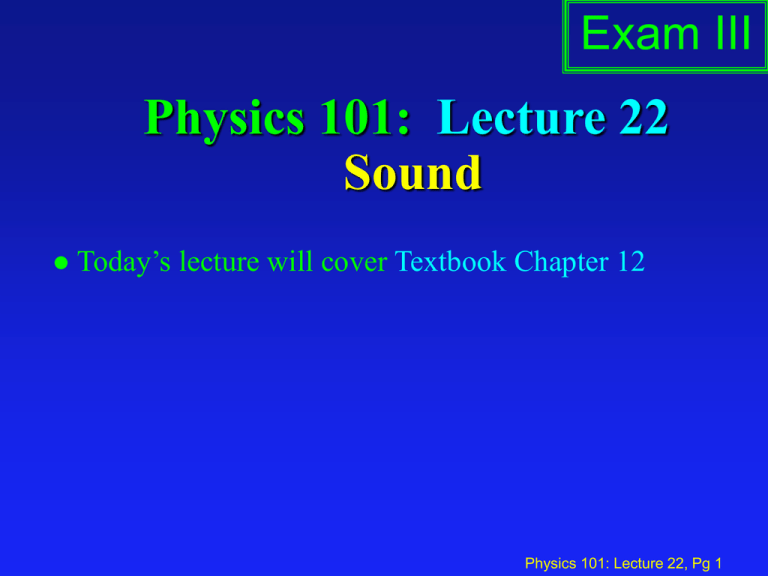
Exam III Physics 101: Lecture 22 Sound Today’s lecture will cover Textbook Chapter 12 Physics 101: Lecture 22, Pg 1 Speed of Sound for pulse on string: v = sqrt(F / m) For fluids: v = sqrt(B/r) Recall Medium Speed (m/s) Air 343 Helium 972 Water 1500 Steel 5600 Physics 101: Lecture 22, Pg 2 Helium ACTs A sound wave having frequency f0, speed v0 and wavelength l0, is traveling through air when in encounters a large helium-filled balloon. Inside the balloon the frequency of the wave is f1, its speed is v1, and its wavelength is l1 Compare the speed of the sound wave inside and outside the balloon A. v1 < v0 B. v1 = v0 C. v1 > v0 Compare the frequency of the sound wave inside and outside the balloon A. f1 < f0 B. f1 = f0 C. f1 > f0 Compare the wavelength of the sound wave inside and outside the balloon A. l1 < l0 B. l1 = l0 C. l1 > l0 Physics 101: Lecture 22, Pg 3 Intensity and Loudness Intensity if the power per unit area. I = P / A Units Watts/m2 For Sound Waves I = p02 / (2 r v) Proportional to p02 note Energy goes as A2 Loudness (Decibels) Loudness perception is logarithmic Threshold for hearing I0 = 10-12 W/m2 b = (10 dB) log10 ( I / I0) b2 – b1 = (10 dB) log10(I2/I1) Physics 101: Lecture 22, Pg 4 Decibels ACT If 1 person can shout with loudness 50 dB. How loud will it be when 100 people shout? 1) 52 dB 2) 70 dB 3) 150 dB Physics 101: Lecture 22, Pg 5 Intensity Preflight Suppose you are standing a distance D away from a speaker that is radiating sound in a spherically uniform way. You walk away from the speaker until the loudness of the sound is reduced by a factor of two. About how far from the speaker are you now? (neglect any reflections from the ground) 1. 10D 2. 4D 3. 3D 4. 2D Physics 101: Lecture 22, Pg 6 Intensity ACT Recall Intensity = P/A. If you are standing 6 meters from a speaker, and you walk towards it until you are 3 meters away, by what factor has the intensity of the sound increased? 1) 2 2) 4 3) 8 Physics 101: Lecture 22, Pg 7 Standing Waves in Pipes Open at both ends: Pressure Node at end l = 2 L / n n=1,2,3.. Open at one end: Pressure AntiNode at open end :l = 4 L / n n odd Physics 101: Lecture 22, Pg 8 Organ Pipe Example A 0.9 m organ pipe (open at both ends) is measured to have it’s first harmonic at a frequency of 382 Hz. What is the speed of sound in the pipe? L=0.9 m Physics 101: Lecture 22, Pg 9 Resonance ACT What happens to the fundamental frequency of a pipe, if the air (v=300 m/s) is replaced by helium (v=900 m/s)? 1) Increases 2) Same 3) Decreases Physics 101: Lecture 22, Pg 10 Preflight 5 As a police car passes you with its siren on, the frequency of the sound you hear from its siren Doppler Example Audio Doppler Example Visual 1) Increases 2) Decreases 3) Same Physics 101: Lecture 22, Pg 11 Doppler Effect When source is moving toward you: Distance between waves decreases Frequency increases fo When source is moving away from you: Distance between waves increases Frequency decreases When moving toward source: Velocity of waves increases Frequency increases fs = vs 1 v When moving away from source: Velocity of waves decreases Frequency decreases fo = f s vo f o = f s 1 v v vo v vs Physics 101: Lecture 22, Pg 12 Doppler ACT A: You are driving along the highway at 65 mph, and behind you a police car, also traveling at 65 mph, has its siren turned on. B: You and the police car have both pulled over to the side of the road, but the siren is still turned on. In which case does the frequency of the siren seem higher to you? f f’ 1. Case A v 2. Case B 3. same vs vo Physics 101: Lecture 22, Pg 13 Interference and Superposition Constructive interference Destructive interference Physics 101: Lecture 22, Pg 14 Superposition & Interference Consider two harmonic waves A and B meeting at x=0. Same amplitudes, but 2 = 1.15 x 1. The displacement versus time for each is shown below: A(1t) B(2t) C(t) = A(t) + B(t) DESTRUCTIVE INTERFERENCE CONSTRUCTIVE INTERFERENCE Physics 101: Lecture 22, Pg 15 Summary Speed of sound v = sqrt(B/r) Intensity B = (10 dB) log10 ( I / I0) Standing Waves fn = n v/(2L) fn = n v/(4L) Doppler Open at both ends n=1,2,3… Open at one end n=1,3,5… Effect fo = fs (v-vo) / (v-vs) Physics 101: Lecture 22, Pg 16
